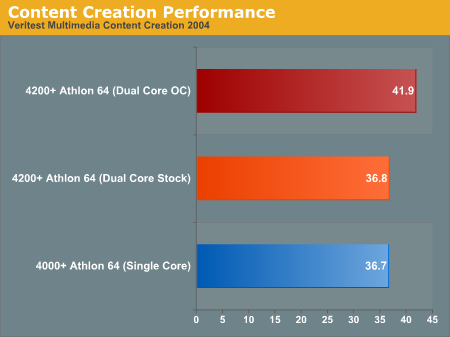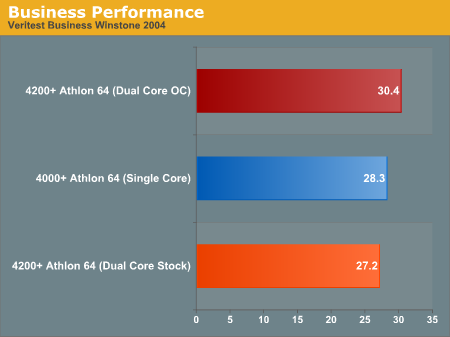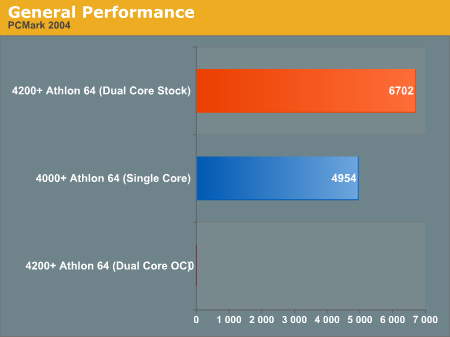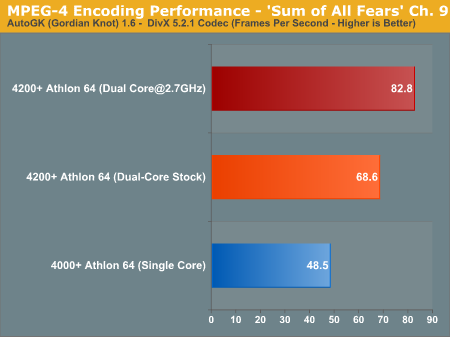General Performance and Media Encoding
Winstones follow an expected pattern with Business Winstone 2004 performing about the same as a similar speed single core CPU. Multimedia Content Creation, however, has some components which benefit from the improved multitasking of the dual-core CPU and it performs better on the dual-core processor. Both Winstones scale very well with CPU speed, so we see a sizable boost in performance at the overclocked 2.7GHz setting.


PCMark2004 is astonishingly sensitive to the multitasking advantages of the dual core 4200+. At stock speed the 4200+ outperforms the higher speed 4000+ by over 35%. PCMark2004 has performed best on the Intel platform in the past, but that advantage appears gone with the launch of the dual-core Athlon 64. We were unable, however, to get PCMark2004 to work at overclocked speeds on the X2 processor. Tests would run, but PCMark04 refused to generate a PCMark2004 score even at modest overclocks. Since Futuremark is preparing to launch PCMark2005 shortly, we suspect this anomaly will be corrected in the new version.

Our AutoGK 1.6 Media Encoding benchmark dramatically shows the impact of Dual-Core on Encoding speed. Comparing the 4200+ to the higher speed single-core 4000+ we find encoding jumps to 68.6 FPS from 48.5 on the single-core. This is a 41% performance improvement. Overclocking the 4200+ to 2.7GHz raises the encoding speed to 82.8 FPS.
Media Encoding was one area where Intel continued to enjoy a small advantage, but it certainly appears the dual-core Athlon 64 will be an excellent choice for media encoding.










53 Comments
View All Comments
Diasper - Thursday, June 23, 2005 - link
Anandtech writers:A recent question that has come up alot (and is something I myself raised) is about the best type of overclock for the dual-core platform. This is particularly regards memory speed and timings and then also with an eye on upgrading to 2GB - if you've got to read Zebos stickied articles in CPU forum you'll know what I mean!
So questions:
- Is the dual-core bandwidth starved at DDR400 and does it benefit from more bandwidth? How much does it benefit (%)? At what speed does it no longer benefit from extra bandwidth/is not bandwidth starved?
- How does changing this FSB relate to timings - which is of greater importance.
- Overclocking with 2GB - alot of people will be looking to get 2GB with these dual-cores. So, in light of the above information what is apparently the best option: 2x 1GB sticks or 4x512MB? This has to bear in mind the inherent 1T vs 2T if using 4 sticks - this will be a good challenge to figure out with all the variables. How much does the 2T affect performance? However, more fundamentally, if the X2 is bandwidth starved upto what speed at 2T with 4 sticks can the memory controller handle? Can it be pushed enough? Does populating all 4 DIMMS cause any other problems/slowdowns - can test at DDR200 + then at overclocked speed (as far as it'll go)
- Final questions, in comparing the 512kb to 1MB caches of the different dual-cores, how much advantage does 1MB provide - if bandwidth starved I'm guessing it may be of significant help as less going into RAM. Would timings and all the above questions I've asked affect the chips differently/different degrees given the different caches - if so then we could ask all the above questions again
In short, I beleive we can't assume the old truths about single-core where only CPU speed mattered. Re-exploring the old assumptions of overclocking needs to be done.
Calin - Thursday, June 23, 2005 - link
Dubb, if I remember correctly there was an article with several single core and multicore processors from both AMD and Intel some time ago. However, I don't think power consumption was detailed much, and performance was tested only on server applications.And Jarred, "you're questions will be answered" should be "your questions will be answered"
JarredWalton - Thursday, June 23, 2005 - link
Googer: Just to let you know, we'll be taking a close look at Venice overclocking soon. This is something of a high-end OC setup, where Venice is the price/performance king right now, seeing that you can get the 3000+ for under $150. So don't worry: you're questions will be answered (more or less) in a future article. :)Bozo Galora - Thursday, June 23, 2005 - link
Once again, Anandtech has let its members down - offering a review that did not address the most basic comparison that a competent review would have included - how does the dual core AMD 4200 CPU stack up against dual Chinese Abacus manipulators, both working while high on methamphetamine, and not.Wesly, you are a Fink!
Dubb - Thursday, June 23, 2005 - link
This is all well and good and all, but I'm still surprised (and a little irratated) that no one (that I can find on the net anyway) has bothered to answer the questions that it would seem to be quite important:for those of us who have near-recent dual processor systems (that is, dual single core), how do these new dual cores stack up?
I'd bet there are lots of folks out there like me (currently on dual 2.66 prestonias) who look at the new dual cores and think "that might be a cheap (comparitively speaking) upgrade"
is the 4800+ stronger or weaker than a comparable 2x250 system? in what areas? how about the 3.2 pentium D vs a dual 3.2 nocona? comparison of power consumption? heat? decent 939 or 775 workstation boards?
it would seem these chips are a possible boon to budget/mid range workstation buyers. But nobody's bothered to look at it from that perspective, aside from running specviewperf vs the single core, single socket chips (which doesn't really help much of anything)
Grumpy dubb
100proof - Thursday, June 23, 2005 - link
The performance statistics are nice and all, but I would assume the main questions resting on most people's minds at the moment are...1. When is supply not going to be an issue?
2. When will the consumer be able to purchase these chips at the prices AMD has specified?
Looking at the few retailers offering these chips for preorder, there is absolutely no shortage of price gouging. The average mark up from AMD's price is between $20-$100 on retail or oem offerings. =/
Wesley Fink - Thursday, June 23, 2005 - link
The 4000+ was the highest "Performance Rated" single-core CPU, which is why it was chosen for comparison. It has also been our standard CPU for motherboard testing for the past several months. Third, it just a little below the 4200+ in cost. So comparing the fastest "rated" single-core to the similarly priced and faster rated Dual-Core made some sense to us.Anand examined DC performance in the launch review, and this article is about overclocking the 4200+. The 4000+ is included just for reference, and there are a multitude of 4000+ benchmarks in motherboard reviews for comparison.
If the performance ratings used by AMD mean anything at all, then the 4200+ should be faster. The 4200+ is faster in some applications than the 4000+ and a bit slower in others. Overall the performance rating seems fair in balance.
michaelpatrick33 - Thursday, June 23, 2005 - link
This also shows the headroom for a 5000+ and 5200+ model running at 2600 is within reach if 2700 is already being hit on air overclocking.drpepper128 - Thursday, June 23, 2005 - link
With the 7800GTX review out and the card seeming to be CPU bound on some of the highest ends, I think it would be interesting to test out this processor in tandem with the 7800GTX.Googer - Thursday, June 23, 2005 - link
I meant Toledo not Manchester